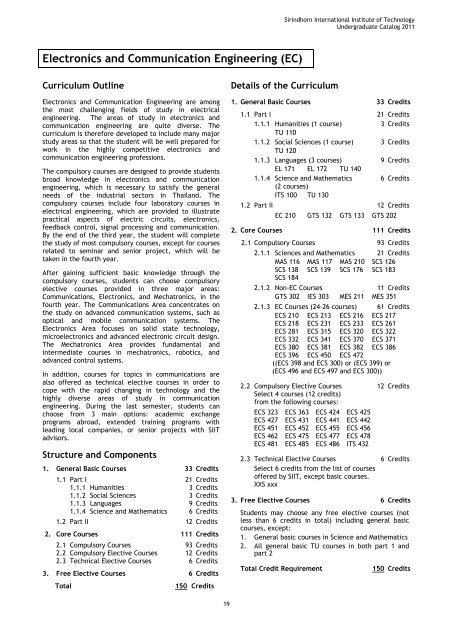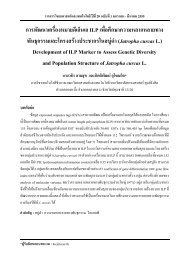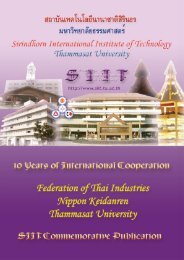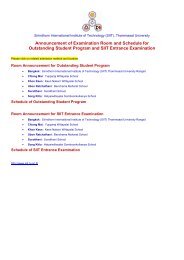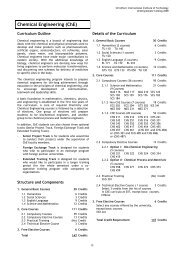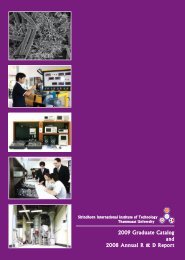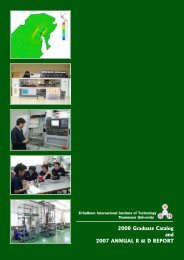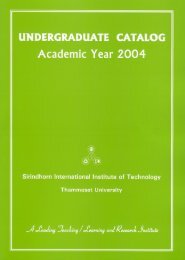Undergraduate Catalog, Academic Year 2011 - Sirindhorn ...
Undergraduate Catalog, Academic Year 2011 - Sirindhorn ...
Undergraduate Catalog, Academic Year 2011 - Sirindhorn ...
Create successful ePaper yourself
Turn your PDF publications into a flip-book with our unique Google optimized e-Paper software.
<strong>Sirindhorn</strong> International Institute of Technology<br />
<strong>Undergraduate</strong> <strong>Catalog</strong> <strong>2011</strong><br />
Electronics and Communication Engineering (EC)<br />
Curriculum Outline<br />
Electronics and Communication Engineering are among<br />
the most challenging fields of study in electrical<br />
engineering. The areas of study in electronics and<br />
communication engineering are quite diverse. The<br />
curriculum is therefore developed to include many major<br />
study areas so that the student will be well prepared for<br />
work in the highly competitive electronics and<br />
communication engineering professions.<br />
The compulsory courses are designed to provide students<br />
broad knowledge in electronics and communication<br />
engineering, which is necessary to satisfy the general<br />
needs of the industrial sectors in Thailand. The<br />
compulsory courses include four laboratory courses in<br />
electrical engineering, which are provided to illustrate<br />
practical aspects of electric circuits, electronics,<br />
feedback control, signal processing and communication.<br />
By the end of the third year, the student will complete<br />
the study of most compulsory courses, except for courses<br />
related to seminar and senior project, which will be<br />
taken in the fourth year.<br />
After gaining sufficient basic knowledge through the<br />
compulsory courses, students can choose compulsory<br />
elective courses provided in three major areas:<br />
Communications, Electronics, and Mechatronics, in the<br />
fourth year. The Communications Area concentrates on<br />
the study on advanced communication systems, such as<br />
optical and mobile communication systems. The<br />
Electronics Area focuses on solid state technology,<br />
microelectronics and advanced electronic circuit design.<br />
The Mechatronics Area provides fundamental and<br />
intermediate courses in mechatronics, robotics, and<br />
advanced control systems.<br />
In addition, courses for topics in communications are<br />
also offered as technical elective courses in order to<br />
cope with the rapid changing in technology and the<br />
highly diverse areas of study in communication<br />
engineering. During the last semester, students can<br />
choose from 3 main options: academic exchange<br />
programs abroad, extended training programs with<br />
leading local companies, or senior projects with SIIT<br />
advisors.<br />
Structure and Components<br />
1. General Basic Courses 33 Credits<br />
1.1 Part I 21 Credits<br />
1.1.1 Humanities 3 Credits<br />
1.1.2 Social Sciences 3 Credits<br />
1.1.3 Languages 9 Credits<br />
1.1.4 Science and Mathematics 6 Credits<br />
1.2 Part II 12 Credits<br />
2. Core Courses 111 Credits<br />
2.1 Compulsory Courses 93 Credits<br />
2.2 Compulsory Elective Courses 12 Credits<br />
2.3 Technical Elective Courses 6 Credits<br />
3. Free Elective Courses 6 Credits<br />
Total<br />
150 Credits<br />
Details of the Curriculum<br />
1. General Basic Courses 33 Credits<br />
1.1 Part I 21 Credits<br />
1.1.1 Humanities (1 course) 3 Credits<br />
TU 110<br />
1.1.2 Social Sciences (1 course) 3 Credits<br />
TU 120<br />
1.1.3 Languages (3 courses) 9 Credits<br />
EL 171 EL 172 TU 140<br />
1.1.4 Science and Mathematics 6 Credits<br />
(2 courses)<br />
ITS 100 TU 130<br />
1.2 Part II 12 Credits<br />
EC 210 GTS 132 GTS 133 GTS 202<br />
2. Core Courses 111 Credits<br />
2.1 Compulsory Courses 93 Credits<br />
2.1.1 Sciences and Mathematics 21 Credits<br />
MAS 116 MAS 117 MAS 210 SCS 126<br />
SCS 138 SCS 139 SCS 176 SCS 183<br />
SCS 184<br />
2.1.2 Non-EC Courses 11 Credits<br />
GTS 302 IES 303 MES 211 MES 351<br />
2.1.3 EC Courses (24-26 courses) 61 Credits<br />
ECS 210 ECS 213 ECS 216 ECS 217<br />
ECS 218 ECS 231 ECS 233 ECS 261<br />
ECS 281 ECS 315 ECS 320 ECS 322<br />
ECS 332 ECS 341 ECS 370 ECS 371<br />
ECS 380 ECS 381 ECS 382 ECS 386<br />
ECS 396 ECS 450 ECS 472<br />
((ECS 398 and ECS 300) or (ECS 399) or<br />
(ECS 496 and ECS 497 and ECS 300))<br />
2.2 Compulsory Elective Courses 12 Credits<br />
Select 4 courses (12 credits)<br />
from the following courses:<br />
ECS 323 ECS 363 ECS 424 ECS 425<br />
ECS 427 ECS 431 ECS 441 ECS 442<br />
ECS 451 ECS 452 ECS 455 ECS 456<br />
ECS 462 ECS 475 ECS 477 ECS 478<br />
ECS 481 ECS 485 ECS 486 ITS 432<br />
2.3 Technical Elective Courses 6 Credits<br />
Select 6 credits from the list of courses<br />
offered by SIIT, except basic courses.<br />
XXS xxx<br />
3. Free Elective Courses 6 Credits<br />
Students may choose any free elective courses (not<br />
less than 6 credits in total) including general basic<br />
courses, except:<br />
1. General basic courses in Science and Mathematics<br />
2. All general basic TU courses in both part 1 and<br />
part 2<br />
Total Credit Requirement<br />
150 Credits<br />
19


